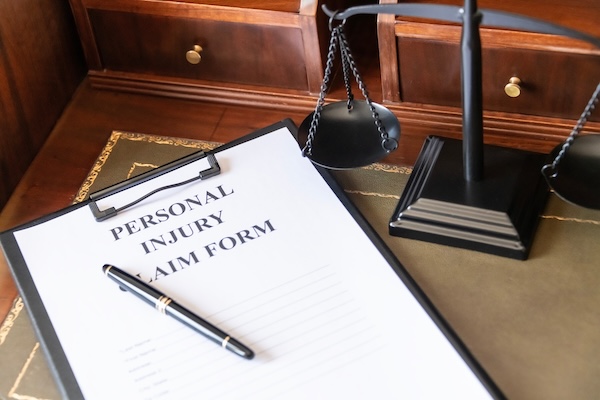Understanding Comparative Negligence in Personal Injury Claims
When you’ve been injured in an accident, determining who is at fault is crucial to your personal injury claim. In North Carolina, the concept of comparative negligence plays a significant role in how fault is assigned and how compensation is determined.
Under this system, if you are partially responsible for the accident, your damages may be reduced based on your percentage of fault. The more negligence you are assigned, the less you may recover, which makes understanding this law vital to the success of your case. A personal injury lawyer can help explain how comparative negligence impacts your claim and ensure you get fair compensation.
Whether you’re dealing with a car accident, slip-and-fall, or another injury, comparative negligence directly impacts your ability to recover damages. In this section, we’ll explain how the rule works, what it means for your case, and why it’s important to have a clear understanding of your role in the accident.
By grasping the concept of comparative negligence, you’ll be better prepared to navigate the complexities of your personal injury claim and pursue the best possible outcome with the guidance of a skilled personal injury lawyer.
What is Comparative Negligence?
Comparative negligence is a principle used in tort law to assign fault in personal injury cases. When an accident occurs, negligence is divided based on each party’s contribution to the incident. This allows the insurance company to adjust the compensation accordingly.
For example, in a car accident, if both drivers are at fault, each would be assigned a percentage of fault. The injured party can still recover compensation based on their level of responsibility, but the amount of damages will be reduced.
In North Carolina, the state follows the modified comparative negligence rule, meaning the plaintiff can recover damages as long as they are less than 50% at fault. If they are found to be 50% or more at fault, they are barred from recovery. This system helps ensure that an individual is fairly compensated for their injuries and property damage while considering the responsibility of both parties involved in the accident.
Types of Comparative Negligence
There are three primary types of comparative negligence rules used in different jurisdictions across the United States. These rules help determine the degree of fault assigned to each party involved in an accident and how compensation is awarded based on their respective responsibilities.
Pure Comparative Negligence
Under the pure comparative negligence rule, an injured party can recover compensation regardless of the percentage of fault they hold. For example, if a person is 80% responsible for an accident, they can still recover 20% of the total damages. This rule is applied in states that allow plaintiffs to pursue compensation no matter how much fault they share.
Even if the plaintiff’s negligence is greater than the other party’s, they can still receive damages, though the compensation will be reduced in proportion to their own negligence. This system is used in about twelve states, including California and New York.
Modified Comparative Negligence
The modified comparative negligence rule is the most common comparative negligence system used across the United States. Under this rule, the injured party can only recover damages if they are found to be less than 50% at fault for the accident. If they are 50% or more responsible, they are barred from recovery. This means that the plaintiff must be less than half at fault to receive compensation.
The amount of compensation is reduced based on the percentage of fault assigned to the plaintiff. North Carolina, along with many other states, follows this rule. For instance, if you are 30% at fault for an accident and the damages are $100,000, you could recover $70,000, but if you’re 50% or more at fault, you won’t be able to recover any compensation.
Slight/Gross Negligence
The slight/gross negligence rule is used in a few states and applies in cases where the negligence of the parties involved is considered in terms of severity. Under this rule, a plaintiff can only recover damages if their negligence is considered slight compared to the gross negligence of the other party.
Essentially, if the other party’s actions are considered significantly more negligent, the injured party may be able to recover damages, even if they share some fault. This rule is typically applied in situations where the accident involves intentional misconduct or severe negligence. It’s less common and only applies in a handful of jurisdictions.
Each of these systems is designed to ensure fairness in personal injury claims by accounting for the degree of negligence on all sides. They help determine who is liable for damages and how much the injured party can recover based on their share of responsibility in the accident.
How Comparative Negligence Affects Personal Injury Claims
Comparative negligence can significantly affect personal injury claims because it determines the amount of compensation the injured party can recover. If the injured party is found to be partially at fault for the accident, their compensation will be reduced according to their percentage of fault.
- If the injured party is 20% at fault for the accident, their compensation will be reduced by 20%, meaning they can only recover 80% of the total damages.
- The more fault the injured party holds, the less they will be able to recover.
Insurance companies use comparative negligence laws to determine liability and assign blame.
- They assess each party’s role in the accident and calculate the degree of negligence for each party involved.
- Based on this, they decide how much compensation the injured party is entitled to receive.
Once the degree of fault is determined, the injured party can negotiate a settlement with the insurance company.
- If the insurance company offers a fair settlement, the injured party may accept it.
- If the settlement is unsatisfactory, the injured party may decide to take legal action and proceed with a court case.
Understanding how comparative negligence works is essential in making informed decisions about your personal injury claim and maximizing the compensation you deserve.
Proving Negligence in a Personal Injury Claim
To prove negligence in a personal injury claim, the injured party must establish four key elements: duty of care, breach of duty, causation, and damages. These elements work together to demonstrate that the defendant was legally responsible for the accident and the resulting injuries.
Duty of Care
The first step is to show that the defendant had a legal obligation to take reasonable measures to prevent harm. This duty of care is typically based on the relationship between the parties involved. For example, a driver has a duty to operate their vehicle safely and follow traffic laws.
Breach of Duty
Next, the injured party must show that the defendant breached their duty of care. This could involve actions such as driving recklessly, failing to maintain property, or disregarding safety protocols. The breach occurs when the defendant’s actions fall below the standard of care expected in that situation.
Causation
Once the breach is established, the injured party must prove that the breach directly caused the accident. Causation involves showing that the accident would not have happened without the defendant’s negligent actions. This link must be clear and direct, demonstrating that the breach of duty was the cause of the injuries inflicted.
Damages
Finally, the injured party must prove that they suffered damages as a result of the accident. This can include tangible damages like medical expenses, lost wages, and property damage, as well as non-economic damages like pain and suffering or emotional distress.
Proving these four elements is essential to establishing negligence in a personal injury claim. The injured party must present strong evidence for each element to show that the defendant was responsible for the accident and the resulting damages.
Recoverable Damages in a Personal Injury Claim
In a personal injury claim, the injured party can recover a variety of damages to compensate for the losses and hardships they’ve experienced due to the accident. These damages can include:
- Medical Expenses: This includes costs related to the injured party’s medical care, such as ambulance fees, emergency room visits, hospitalization, surgeries, physical therapy, medications, and any future treatments required for recovery.
- Lost Income: If the injured party is unable to work due to their injuries, they can recover wages lost during their time off. This can also include any reduced earning capacity if their injuries prevent them from returning to the same level of work or if they are unable to work in the same field again.
- Property Damage: If the injured party’s belongings were damaged in the accident, they can seek compensation for the repair or replacement costs. This can apply to a damaged vehicle, personal items, or any other property that was impacted.
In addition to these direct financial losses, other types of damages can be recovered in a personal injury case, including pain and suffering, emotional distress, and loss of enjoyment of life. These non-economic damages aim to compensate the injured party for the more subjective impacts of the accident, like the physical and emotional toll it has taken on their life.
By understanding the full range of recoverable damages, the injured party can ensure they seek fair compensation for all the losses they’ve endured as a result of their accident.
Resolving Comparative Negligence Cases
Comparative negligence cases can be resolved in two primary ways: through negotiation with the insurance company or by taking the case to court for a trial. The approach depends on the circumstances of the case, including the extent of negligence and the willingness of the parties to settle.
The insurance company plays a significant role in the process, as it often determines the amount of negligence assigned to its insured party. Based on its investigation, the insurance company may offer a settlement to the injured party. This offer is typically based on the company’s assessment of the negligence involved and how much compensation the injured party is entitled to.
The injured party can then negotiate with the insurance company to try and reach a fair settlement. Negotiations may go back and forth until both parties agree on the compensation. However, if an agreement cannot be reached and the parties cannot settle, the case may proceed to court.
In court, the judge or jury will make the final determination of comparative negligence. They will assess the facts of the case, the evidence presented, and decide on the percentage of fault for each party. If the court finds that the injured party is partially responsible, it will reduce the compensation accordingly. If no settlement is reached, the court’s ruling will determine how liability is divided and what damages are awarded.
Special Considerations in Comparative Negligence Cases
Comparative negligence is a type of negligent tort, which falls under one of the three main categories of tort law. A negligent tort occurs when one party fails to exercise reasonable care, resulting in harm to another party. Accidents are common examples of negligent torts, where multiple parties may be at fault for the injuries or property damage that occur.
No-Fault Compensation Funds
In some cases, no-fault compensation funds may be used to compensate the injured party, regardless of who is at fault for the incident. These funds are designed to provide quicker compensation when harm is caused by specific events or circumstances.
Examples of no-fault compensation funds include:
- Workers’ Compensation: Covers injuries that happen on the job, allowing employees to receive compensation for medical expenses and lost wages without needing to prove fault.
- Auto Insurance No-Fault Coverage: Provides compensation for injuries sustained in a motor vehicle accident regardless of who caused the accident. This system helps expedite the process of receiving compensation without the need to establish negligence.
While no-fault compensation funds can provide faster relief, they may limit the ability of the injured party to pursue additional legal action or seek full damages in a personal injury claim.
The Role of a Personal Injury Lawyer
A personal injury lawyer plays a crucial role in helping the injured party navigate the complexities of a personal injury claim. Their expertise and support can make a significant difference in the outcome of the case, particularly when comparative negligence is involved.
Collecting Evidence
One of the first tasks of a personal injury lawyer is to gather as much evidence as possible to support the claim. This can include:
- Photos of the accident scene, damages, and injuries.
- Witness statements from individuals who saw the accident occur.
- Medical records that document the extent of the injuries and the necessary treatments.
Having strong evidence is crucial to building a compelling case and proving fault.
Negotiating with Insurance Companies
A personal injury lawyer will handle negotiations with the insurance company to reach a fair settlement. Insurance companies often aim to minimize the amount they pay out, so having a skilled lawyer to advocate on your behalf can help ensure you receive the full compensation you’re entitled to. If a settlement cannot be reached, the lawyer will represent the injured party in court.
Explaining Rights and Options
Another important role of a personal injury lawyer is to help the injured party understand their rights and options under comparative negligence laws. The lawyer will explain how negligence may impact the claim, what damages can be recovered, and how the percentage of fault will affect the amount of compensation. By understanding these factors, the injured party can make more informed decisions about how to proceed with their case.
In summary, a personal injury lawyer is an invaluable resource when pursuing a personal injury claim, helping to gather evidence, negotiate settlements, and provide expert legal guidance throughout the process.
Common Mistakes to Avoid
When pursuing a personal injury claim, it’s important to avoid certain mistakes that can affect your chances of receiving fair compensation. Here are the most common ones:
- Not Seeking Medical Attention Immediately
Failing to get checked by a doctor after the accident can worsen injuries and hurt your case. Immediate medical attention helps document your injuries. - Not Keeping Accurate Records
Keep detailed records of all medical expenses, lost income, and property damage. These records are crucial to proving the financial impact of the accident. - Giving Statements to the Insurance Company Without Legal Advice
Avoid speaking to the insurance company without consulting a lawyer. Your words can be used against you, reducing the compensation you’re entitled to. - Accepting a Settlement Offer Without Consulting a Lawyer
Insurance companies may offer a quick settlement that’s lower than what you deserve. Always consult a lawyer before accepting any offer to ensure you’re getting fair compensation.
By avoiding these mistakes, you can ensure that your personal injury claim is handled effectively and that you receive the compensation you deserve.
Why Choose 1 Charlotte Injury Lawyers?
Choosing the right law firm can make all the difference when pursuing a personal injury claim. At 1 Charlotte Injury Lawyers, we offer the experience, dedication, and personalized attention needed to help you navigate the complexities of comparative negligence and secure the compensation you deserve. Here’s why we stand out:
Extensive Experience in Personal Injury Cases
With years of experience handling a wide range of personal injury claims, we understand the intricacies of comparative negligence laws and how to effectively advocate for our clients.
Proven Track Record of Success
Our team has a proven history of securing favorable settlements and verdicts for clients in Charlotte and surrounding areas. We’re committed to achieving the best possible outcome in every case.
Personalized Attention and Support
We believe in treating every client with the care and attention they deserve. From your initial consultation to the final resolution, we’ll guide you through every step of the process, ensuring you understand your rights and options.
Aggressive Representation
Whether negotiating with an insurance company or representing you in court, we fight hard to protect your interests and ensure you receive the compensation you deserve.
No Upfront Fees
We work on a contingency fee basis, meaning you don’t pay us unless we win your case. This ensures you can access experienced legal representation without worrying about upfront costs.
When you choose 1 Charlotte Injury Lawyers, you’re choosing a team of committed and experienced professionals who will fight for your rights and ensure you get the compensation you deserve.
Get the Compensation You Deserve – We’re Here to Help!
If you’ve been injured in an accident and need experienced legal representation, 1 Charlotte Injury Lawyers is here to help. Our team is ready to guide you through the complexities of your personal injury claim and fight for the compensation you deserve. Whether it’s negotiating with an insurance company or representing you in court, we’re committed to achieving the best possible outcome for your case.
Contact us today to schedule a free consultation and start the process of recovering the damages you’re entitled to. Don’t wait—let our experienced team help you every step of the way.
Call 1 Charlotte Injury Lawyers at (704) 706-2689 now to get started.









